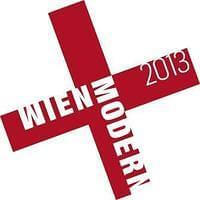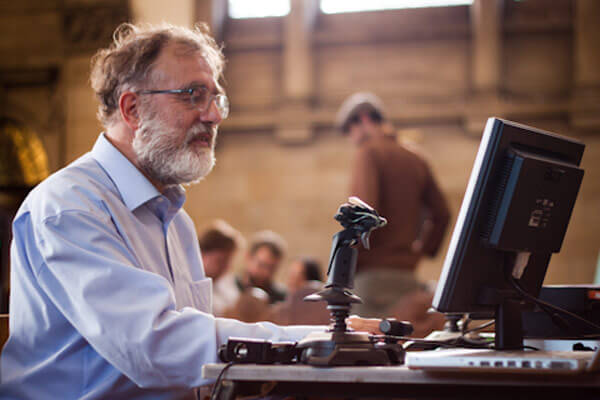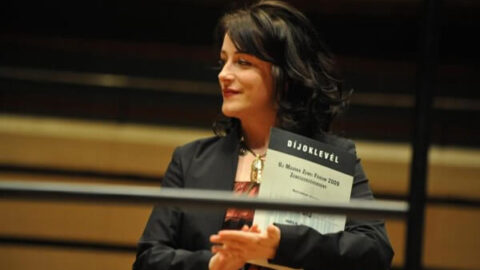 Focusing on the subtle, quiet textures of a small chamber ensemble in a still room can be a meditative experience, as many introverts sit quietly together in the intimacy of an established performance structure. This was the scene in the Berio room at the Vienna Concert House on Sunday, November 10, 2013, as Ensemble die reihe gave a concert of short, introverted chamber pieces. On this evening, part of the Wien Modern festival, it was the Hungarian composers who stole the show, including the premiere of an intriguing work by Judit Varga.
Focusing on the subtle, quiet textures of a small chamber ensemble in a still room can be a meditative experience, as many introverts sit quietly together in the intimacy of an established performance structure. This was the scene in the Berio room at the Vienna Concert House on Sunday, November 10, 2013, as Ensemble die reihe gave a concert of short, introverted chamber pieces. On this evening, part of the Wien Modern festival, it was the Hungarian composers who stole the show, including the premiere of an intriguing work by Judit Varga.

The concert opened with three short pieces by Hungarian Peter Eötvös, whose work is being showcased at this year’s Wien Modern festival. We heard percussionist Josef Gumpinger perform Eötvös’ Thunder for one bass timpano (1993), a short and surprisingly melodic rumble, showcasing the tone colours available from one single kettle drum. Psy for Flute, Cello and Piano (1996) toyed with an audience’s expectation of this combination of instruments: here, the piano played slow and deliberate melodic material while the flute and cello provided accompanying textures. Gottfried Rabl performed Erdenklavier- Himmelklavier (2003/2006) (Earthly piano- heavenly piano) with great clarity. In this short piece, heaven is a series of gentle cluster chords, surrounded by a simple, earthly stepwise melody. These three Eötvös pieces were all airy, leaving lots of space between each individual texture, but also kept a melodic thread throughout.
There were two more solo percussion pieces on the program, the premiere of Bernd Richard Deutsch’s ictus for solo percussion (2011) and Portugal for solo percussion (2006) by Johannes Maria Staud. Deutsch’s piece used small drums and woodblock sounds, developing a heartbeat figure that inverted and built to a hammering. Staud used a softer percussion pallette, tempering his drums with cymbals and gongs.

The most introverted portion of the program focused on the minutiae of sound. Reinhard Fuchs’ gereist in feldern durch zeit for bass flute/piccolo and percussion (2000) contrasted gestures and material played first on a piccolo and then again on a bass flute, accompanied by open, ringing textures in the percussion, which used lots of bowed cymbals, gongs and vibraphone to create an ethereal texture. This airiness was contrasted with aggressiveness in Alexander Stankovski’s Gegenbilder for Flute, clarinet, violin and cello (1993-2003). The first part of this piece was slow and sustained with lots of space between each gesture; the second was flustered, filled with repeated fluttering patterns and pecking sounds. Gerd Kühr’s Ohne Antwort for flute, clarinet, percussion, violin, viola and cello (1993) was also focused on the details of each sound produced. Opening with several hard strokes on the snare drum, the piece continued with muted strings playing quarter tones in close proximity, the winds making little rhythmic events by clacking their keys and ended with a grounding bass clarinet line, rising under more delicate sounds.
The evening ended with the premiere of Judit Varga’s Dietro la musica- 5 Divertimenti for flute, clarinet, violin, viola, cello and piano (2013), a commission from the art association Alte Schmiede. These fascinating divertimenti incorporated the sparse aesthetic of the previous works on the program, and added several other influences to make a satisfying and dramatic work. The piece opened with the pianist in darkness, the rest of the ensemble and conductor in light. The clarinet and flute played an off-kilter rhythmic game that began on two, then three notes. The string trio had light and sustained chords over top, and this texture built until it became one urgent, rising scale fragment. And suddenly there was Mozart, with clear, tonal chords and ringing voicings, which quickly melted back into sustained, scratchy murk. Varga’s gestures often repeated themselves, with a series of items following each other several times in a delightfully obsessive way. Impossibly slow bowings and tiny sounds were followed by another Mozartian moment. After the music fell one last time from bright and hard classical edges into a sul-pont mire, the lights on the piano suddenly went up. Stephanie Timoschek-Gumpinger shone in the virtuosic passage that followed. Her flair carried us from a ferocious series of figures on the bass end of the piano, rising gradually with fast lines and polyrhythms to the very top of the instrument. Several oscillating rhythmic patterns followed quickly, settling in before being whisked away for the next. As the piano finally began to lose energy, the quintet returned with quiet notes, and the lights on the whole stage began to fade. As darkness came into the room, we were left with a few major sounds, ending on a sustained chord in complete darkness.
























